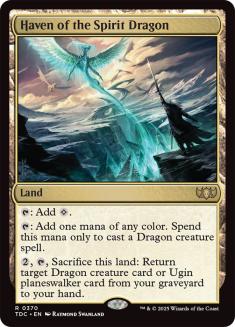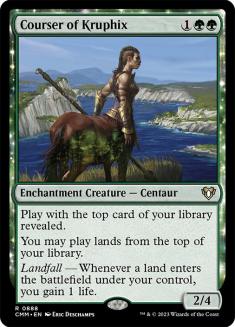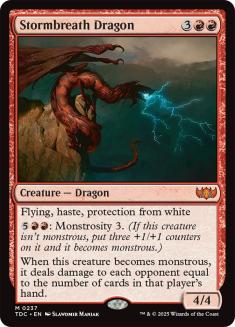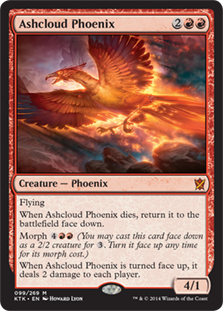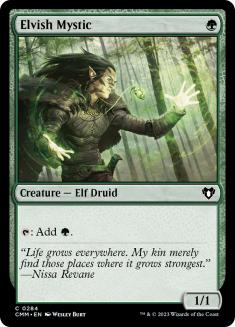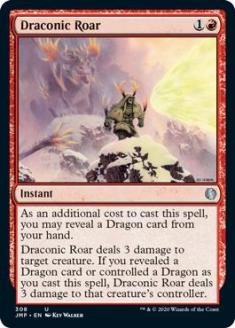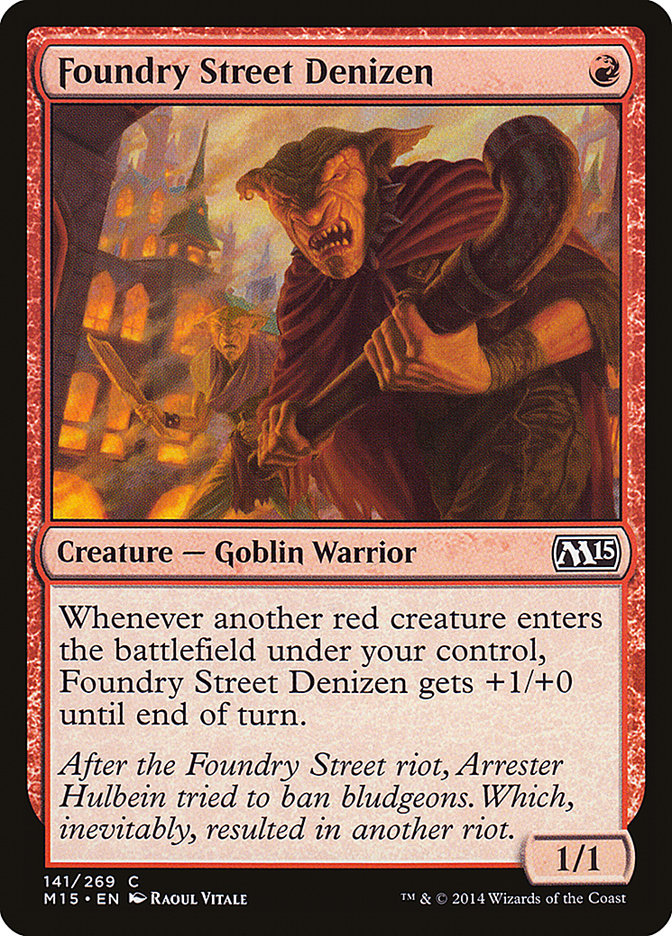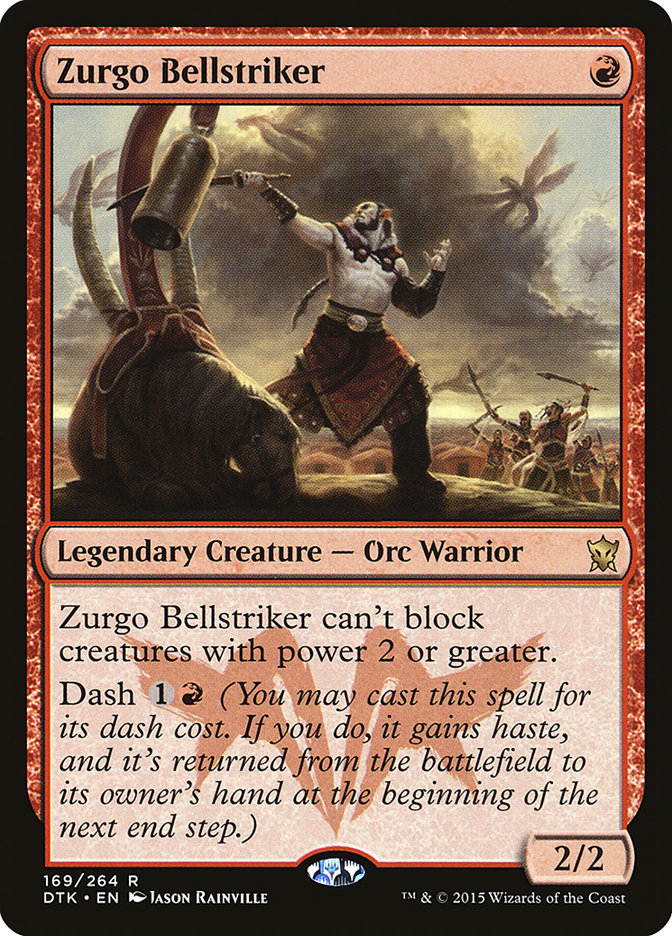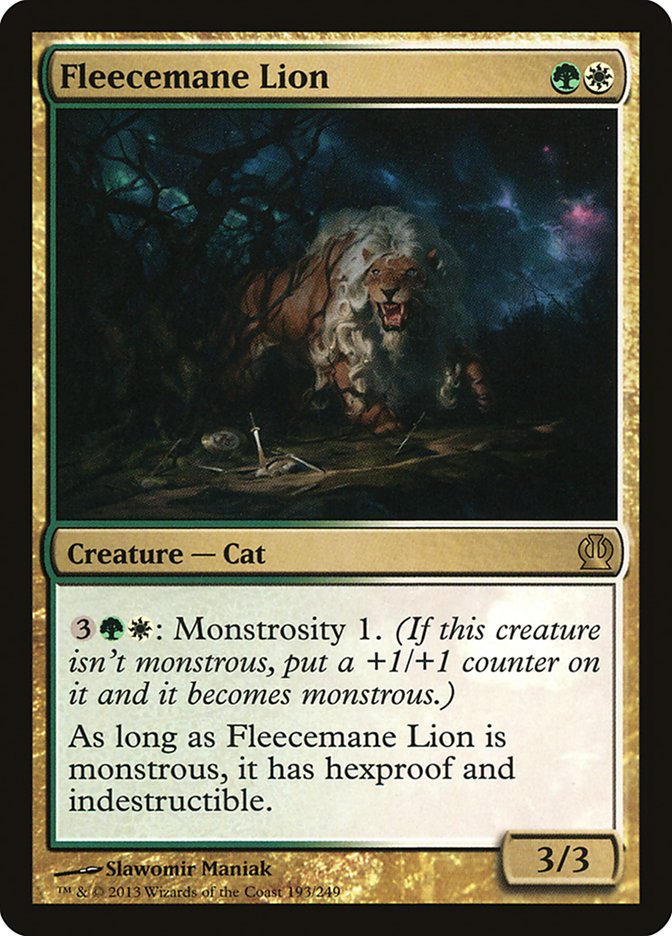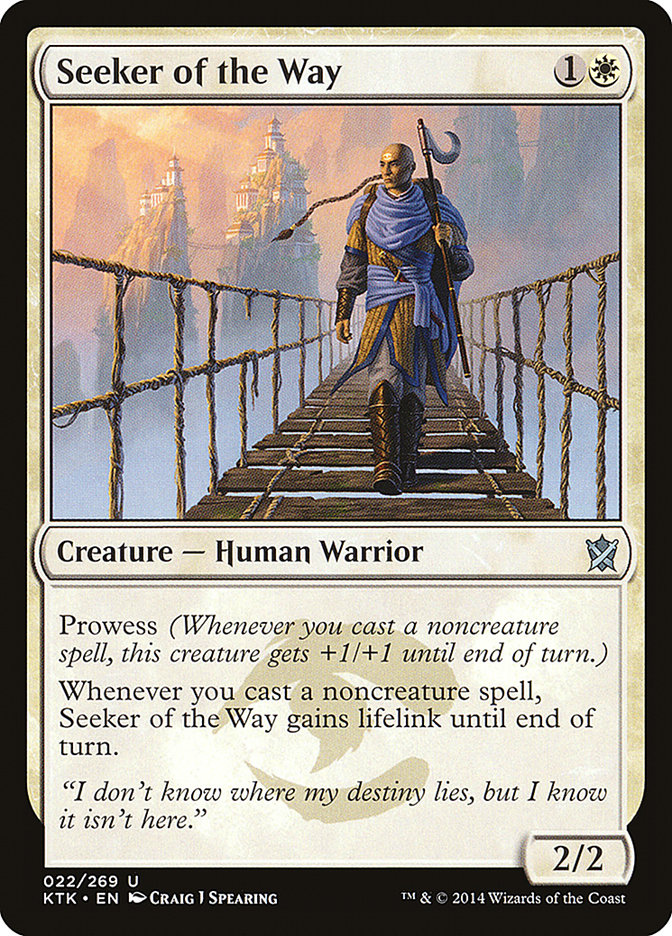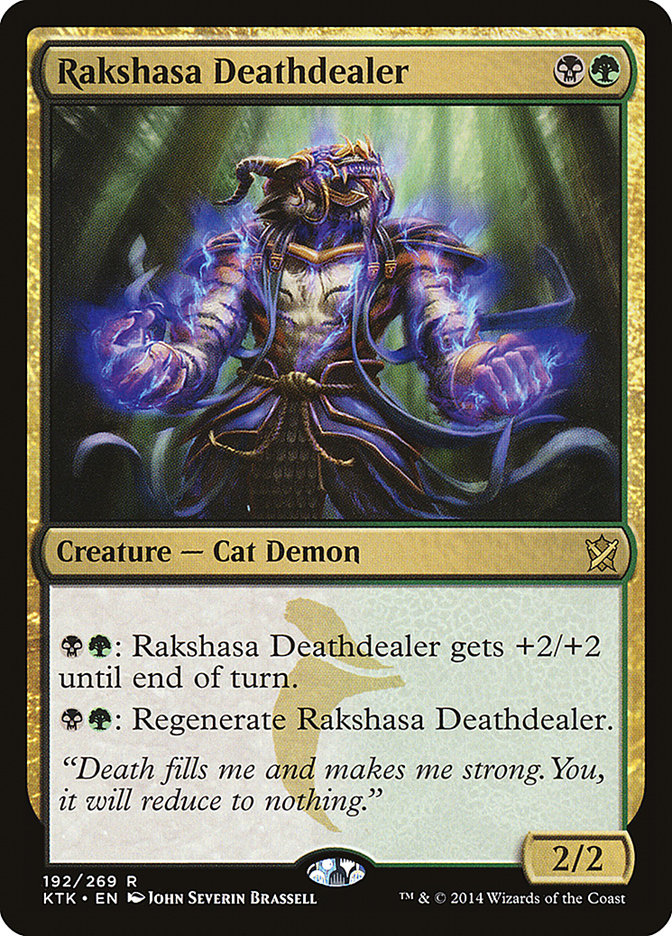Ever since the Pro Tour, G/R Dragons has pretty much fallen by the wayside. There are many reasons for this, but these are the ones that stick out to me
the most:
People figured out Thunderbreak Regent
If you put G/R on the backfoot hard enough, you’ll never be able to make any relevant momentum out of the three damage that it gives you. If a Sorin,
Solemn Visitor is the follow up, even that sturdy 4/4 body isn’t going to be enough to mitigate the life swing. G/R decks love to push, but when the deck
is getting pushed back harder, then you’re forced into a flimsy defensive position with aerial threats that want to attack. Lastly, general answers like
Elspeth, Sun’s Champion were always good against you, and a well-timed one will mean its demise.
Your manabase isn’t as clear cut as you initially thought
This masterpiece of a hand is what I mean:
Or this immaculate form of artistry:
It ain’t pretty, that’s for sure.
There were plenty of times where your Havens of the Spirit Dragon would bite your Courser of Kruphix hands, stymieing what would be an incremental
advantage toward your mid-game. The bridge that set you up, the alley to your oop, was under construction for the time being, but those Siege Rhinos and
Deathmist Raptors and Goblin Rabblemasters aren’t going to wait for you to finish building that bridge.
They’re going to get you “Ded.”
Your real contenders were the Dragons. Everything else felt like filler.
Thunderbreak Regent, Stormbreath Dragon, and even Dragonlord Atarka herself are the big selling points to playing the deck in the first place. When we had
Goblin Rabblemasters, Boon Satyrs, and Surrak, the Hunt Caller, we were at least able to pretend to have a solid supporting cast. When that was figured
out, we had to punish the other G/R decks for not keeping up (right down to the sideboarded Mob Rule).
Now, the latest iteration is being punished for exactly that, and it’s time to once again reevaluate where we want to be.
So, with all of this in mind, where do we go?
Well, one way is to figure out where the big selling points of the format are as a whole. It’s pretty clear the Den Protector and Deathmist Raptor are both
pillars of the format, and incorporating them into a different shell, while nothing new, could be just what the deck needed
Creatures (29)
- 4 Elvish Mystic
- 4 Stormbreath Dragon
- 3 Boon Satyr
- 4 Rattleclaw Mystic
- 2 Ashcloud Phoenix
- 4 Thunderbreak Regent
- 4 Den Protector
- 4 Deathmist Raptor
Lands (24)
Spells (7)

This looks very close to what AJ Kerrigan had going at the Season One Invitational, and I think it’s worth revisiting. Heir of the Wilds was always kind of
dinky, so a swap for Den Protector fits pretty nicely. Of course, there’s the combo of Den Protector and Boon Satyr, but the real selling point is the more
reliable manabase. Just having 24 land in general will make things easier on you, as you won’t want to be leaning so hard on your mana accelerants to begin
with. You’ll want less Draconic Roars and Roasts in game 1 since being proactive and keeping the wheels turning is much more important in game 1,
especially against Esper Dragons and Abzan anything. The way you lose is getting hit harder than you’re hitting them, both literally, and strategically.
Another option for Thunderbreak Regent is a heavy attrition route.
Creatures (14)
Lands (25)
Spells (21)

I made a post on Facebook not too long ago, about a few days before the Open Series in Cleveland: I wanted to play a deck with Thunderbreak Regent,
Stormbreath Dragon, and Dragonlord Ojutai. They’re all pretty absurd cards, and finding a shell that could utilize all of them would be sweet.
Then Michael Flores dropped a bombshell on the format in Five-Color Blue Dragons, and it ignited the ambition in me that I haven’t had in a very long time.
It was the culmination of everything I wanted in a Dragons deck, and a control deck for that matter:
Dragons.
Big Dragons.
An extreme amount of permission.
“Titan” style effects, huge bombs that instantly change the complexion of the game by themselves.
Even bigger Dragons.
And a whole lot of manipulation.
I got to jam the bad boy at FNM, and it was an absolute blast to play. There are definitely a lot of games you have to work hard to win, which can
certainly be a strike against it. The benchmark for blue control is Esper Dragons, and that deck can very easily get free wins much more often by just
curving out and crushing everything from the get go. That said, you are certainly a deck that can fight Esper Dragons very well. In fact, I’d even go as
far as to say that it’s a good matchup. Crucible of the Spirit Dragon and Haven of the Spirit Dragon combine to create this incredible amount of efficiency
and inevitability that is unmatched in blue mirrors.
Creatures (10)
Planeswalkers (1)
Lands (27)
Spells (22)

Now that we have this technology available to us, I figured it was time to see exactly how much we can do with it.
I didn’t really know where to start, mostly because the previous time I tried to splash didn’t work out at all. Remember Temur Dragons? Yeah, that didn’t
work out so well.
You aren’t going to hit home runs all the time. Hitting base hits are important too, and you aren’t going to find something good if you don’t try.
And try I will.
Creatures (30)
- 4 Sylvan Caryatid
- 4 Stormbreath Dragon
- 3 Courser of Kruphix
- 4 Rattleclaw Mystic
- 2 Dragonlord Atarka
- 4 Thunderbreak Regent
- 2 Dragonlord Dromoka
- 3 Den Protector
- 1 Dragonlord Kolaghan
- 3 Dragonlord Ojutai
Lands (25)
Spells (5)

Sylvan Caryatid is the real catalyst for this build, as it really lets you be as greedy as you want. There are a lot of ideas borrowed here; the foundation
of Brad Nelson’s Four-Color Midrange deck way back in Richmond, the stems of Bennie Smith’s version of the deck, the manabase of the aforementioned
Five-Color Blue Dragons deck, and finally, the good parts of Chris VanMeter’s G/R Dragons deck.
I immediately went to Gerry Thompson about it, knowing that he’d find ways to improve it almost instantly, and as per usual, he didn’t disappoint.
– Crucible of the Spirit Dragon isn’t nearly as good in this deck as it is in Blue Dragons. There will be less opportunities to charge it up, and if we’re
just using it to charge once, then we might as well Mana Confluence. Mana Confluence casts Sylvan Caryatid as well. Blue Dragons has access to it too, but
their life is much more valuable of a resource.
– More Dragonlord Atarka. She is the midrange trump, and jamming as many as possible is going to help way more than a smattering of other random Dragons.
We need to be able to hit them hard, and she is great at basically eating anything that would be problematic.
– See the Unwritten. I completely forgot about this one, and it’s yet another way to jam more Dragons without actually putting more Dragons in the deck.
When you go up to the full four Dragonlord Atarka, then you’re even more incentivized to get these in there.
With this newly equipped knowledge, I came up with this:
Creatures (32)
- 4 Sylvan Caryatid
- 4 Stormbreath Dragon
- 3 Courser of Kruphix
- 4 Rattleclaw Mystic
- 4 Dragonlord Atarka
- 4 Thunderbreak Regent
- 2 Dragonlord Dromoka
- 3 Den Protector
- 1 Dragonlord Kolaghan
- 3 Dragonlord Ojutai
Lands (25)
Spells (3)

Many of the borrowed ideas remained, but we now have a cleaner Dragon suite and a much more streamlined gameplan. Now, we can just strongarm our way
through most decks that aren’t trying to get under us quickly.
And that’s the issue that concerns me.
Similar to the Five-Color Blue Dragons deck, there are a ton of one-drops (and a large number of two-drops) that give you huge fits.
Among many, many others.
Encase in Ice isn’t the cleanest thing, but at least the Blue Dragons deck has that. The best we can do is Draconic Roar, but where do we make room? It’s
possible that we can get away with one less non-Thunderbreak Regent, non-Dragonlord Atarka Dragon, but it feels so rough to do that. In addition, doing
that means less of a chance to hit with your See the Unwritten. Blocking with Den Protector and/or Rattleclaw Mystic may be just fine if things get really
scrappy, but this is the area where you’d want to play the blue version. Silumgar’s Scorn, Dissolve, and Perilous Vault are just the best tools available
for that deck. Here, you’re probably just hoping to jam a large threat and hope it’s good enough to kill them, or keep you alive long enough to find one
that kills them. This plan isn’t the worst if there’s a shift toward decks like Abzan Aggro or even further inbred Esper Dragons metagames, but for now,
this deck may be a bit too far ahead to really pull the trigger on.
It’s a weird concept, being “too” far ahead, right? I promise you it isn’t a pretentious assumption or anything like that. What I mean is that a deck,
strategy, or archetype may be good for a metagame that hasn’t gotten to the point where your plan would be effective. If you predict that G/R Dragons will
be a big deck in two weeks, you don’t want to be stocking up on Ultimate Prices the week before then. To put it even more simply: Don’t fight the battle
after the one you’re going to be in.
I will be in Dallas for the Open Series in two weeks, and I couldn’t be more excited to once again visit the beautiful state of Texas. Once again partnered
with Dan Jessup and Jim Davis, I’m hoping to have more fun meeting new players, hanging out with old ones, and getting hit with a Crater’s Claws for ten
million damage!

